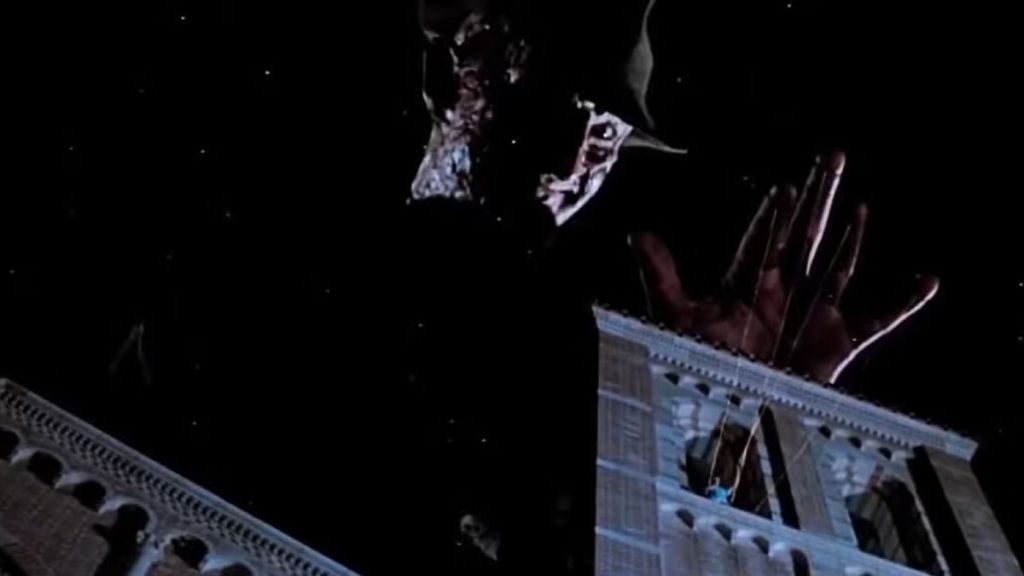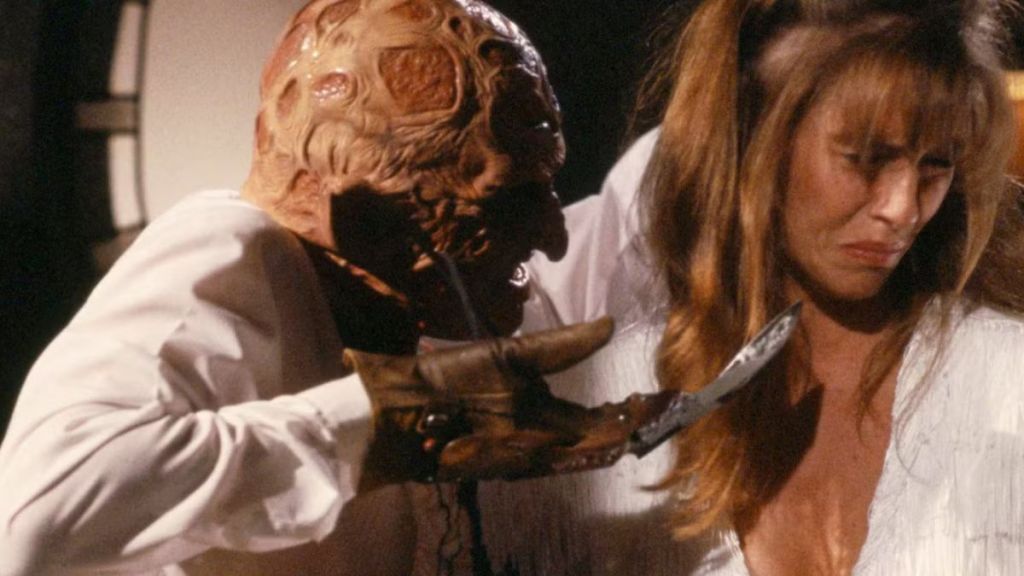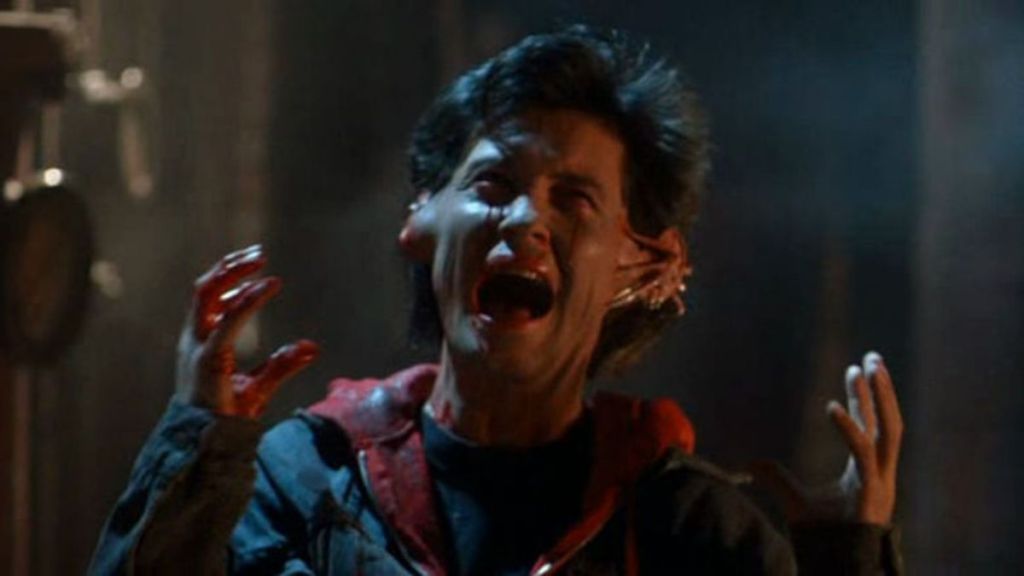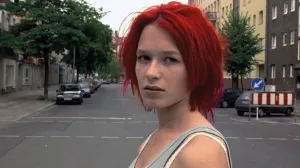Wes Craven’s A Nightmare on Elm Street kicked off not just a successful franchise, but a pop culture phenomenon as well. Yet, at its core, it has the same appeal as the Friday the 13th franchise: particularly inventive kills. And, throughout six mainline films, an early example of meta horror, and a crossover with Jason Voorhees, the franchise blessed horror with some of its most compellingly unique character send-offs. The best of the bunch follow. Just don’t expect to see anything from the horrendous 2010 remake (all due respect to Jackie Earle Haley’s best efforts), because there wasn’t anything from even Wes Craven’s New Nightmare or Freddy vs. Jason that made the razor-gloved cut.
Videos by ComicBook.com
On one hand, this is because New Nightmare is light on kills and Jason does the vast majority of the killing in Freddy vs. Jason. On the other hand, it’s because the bloody dream sequences seen in the earlier films were just so good.
1) Tina Gray in A Nightmare on Elm Street

Even factoring in Scream, A Nightmare on Elm Street remains the late Wes Craven’s best movie. Sublimely paced and, as one could guess given the title, amply dreamy, it was the exact shot in the arm the dwindling slasher subgenre needed in 1984. Furthermore, while Freddy was always a formidable antagonist, this was the one movie where he seemed truly, horrifically dangerous.
The key to that impact is two-fold. For one, he’s not shown much. He’s far from the wiseacre true head of the IP he’d become. Secondly, two of his four kills in the original film are absolute bloodbaths. It’s tough to watch the characters go out that way, too, because they’re so likable. We don’t get much time to know Tina Gray, as she’s only in the first 20 or so minutes, but her presence remains throughout the entirety of the runtime (and not just because Nancy dreams of her rotting, bug-covered corpse at one point). We’re haunted by the memory of her getting dragged up her bedroom wall, the four claw marks on her stomach gushing blood. Perhaps not coincidentally, the film’s other great character send-off also involved the technique of the spinning room. Speaking of which….
2) Glen Lantz in A Nightmare on Elm Street

As mentioned, the death scene for Johnny Depp’s Glen Lantz was crafted via the same technique as Tina Gray’s offing. Specifically, a manually rotated room. There, though, the death is drawn out. Here, the effect is put to a more instantaneous use (though the buildup to the death itself is also drawn out).
Like with Kevin Bacon in the original Friday the 13th, there’s something pop-culturally significant about seeing a future A-lister in the very first installment of one of slasher cinema’s few genuinely A-list IPs. And, just as the end of Bacon’s Jack was iconic in Friday the 13th, so too is the one experienced by Depp’s Glen in A Nightmare on Elm Street. We watch Glen laying back with his headphones on and a TV running just off-screen. We know he’s going to fall asleep. And, while we watch him doze, Freddy’s glove emerges from the bed, wraps around Glen, and pulls him down into the mattress. He’s replaced with a blood geyser. It’s startling imagery and thank goodness they took out the scene that followed, which had Glen emerge (missing not a single piece of his body) from the bed, coated in blood, at which point he falls forward. With the excising of that final moment, we’re forced to imagine what’s happening to Glen in that mattress that results in a water park’s worth of blood.
3) Phillip Anderson in A Nightmare on Elm Street 3: Dream Warriors

The original A Nightmare on Elm Street is the best A Nightmare on Elm Street, but the mental health clinic-based third film ranks awfully close. For one, Patricia Arquette and Laurence Fishburne are in it. Two, it succeeds both in crafting unique characters and equally unique sendoffs for those characters. It set the tone for the franchise just as much if not more so than the original film and was a much-needed course correction after the misguided (but interesting) A Nightmare on Elm Street 2: Freddy’s Revenge.
Each of the film’s six death scenes are top tier A Nightmare on Elm Street stuff, starting with Phillip Anderson’s. It starts with a puppet who looks an awful lot like Freddy slash his restraining control strings and grow to full size. He then switches from puppet to puppeteer, and Phillip is his Pinocchio. The strings are coming out of Phillips’ arms, and Freddy gleefully walks him to the edge of the hospital’s highest tower. The hospital’s other patients watch in horror as Phillip, who seems to be awake (and has a history of self-harm), has the strings cut, and he plummets to his death.
4) Jennifer Caulfield in A Nightmare on Elm Street 3: Dream Warriors

Even factoring in Halloween 4: The Return of Michael Myers and Friday the 13th: The Final Chapter, A Nightmare on Elm Street 3: Dream Warriors is the definitive classic slasher sequel. If it weren’t for Scream 2 and Scream (2022), it would be a shoe-in for best slasher sequel, period (and, honestly, it still might be after factoring in those Ghostface sequels).
It also may have the single most famous line in slasher movie history. Specifically, when Freddy, as a television, pulls up the sleep-deprived Jennifer and says “This is it, Jennifer, your big break in TV! Welcome to primetime, bitch!” The latter part is the iconic part and, impressively enough, it was improvised by Freddy himself, Robert Englund.
[RELATED: This Freddy Krueger Detail from A Nightmare on Elm Street Is Still Up for Debate (So What’s the Truth?)]
5) Debbie Stevens in A Nightmare on Elm Street 4: The Dream Master

Widely deemed the MTV version of a Freddy Krueger movie, A Nightmare on Elm Street 4: The Dream Master exists in a weird quality nebulous. On one hand, it’s often as inventive as Dream Warriors, but it also started to show Freddy skew more towards comedic leading man than the sparsely seen antagonist he should be. With Dream Warriors, it really did come down first and foremost to character. The kill scenes, while mostly brilliant, were second to that.
In The Dream Master, it’s only really the latter factor that is still nailed. For instance, the offing of Debbie Stevens, which was and remains one of the franchise’s most famous sequences. The best Elm Street deaths, at least after the original film, were tailored to the character’s own personal fears and history. With Debbie, the final character to die in the film, Freddy targets and exploits her entomophobia, or fear of bugs. Most people shiver at the sight of a cockroach scurrying across their kitchen floor, but to be turned into one? That’s a bridge too far. At least Freddy puts her out of her misery (eventually) via a squished roach motel.
6) Greta Gibson in A Nightmare on Elm Street 5: The Dream Child

A Nightmare on Elm Street 5: The Dream Child may be the final installment to have that classic Elm Street vibe, but it’s a pale imitation of the installments that preceded it (especially the third and fourth entries). There are aspects about it that work, but it frequently buckles under the weight of the IP’s increasingly complex mythology.
It also shorts the audience on kills. There are three total, and only one of them really works. Mark’s comic book sequence and Dan’s motorcycle man sequences are too bizarre to work, but Greta’s does. Like the best Elm Street kills, it’s a character offing that merges the individual’s real world concerns or obsessions with a heightened dreamscape reality. In the case of Greta, it’s retaining a slim weight for a career as a model. Unfortunately, this kill was edited down to its bare bones, but we still get the point: Freddy feeds Greta her own internal organs.
7) Carlos Rodriguez in Freddy’s Dead: The Final Nightmare

Freddy’s Dead: The Final Nightmare is a letdown of a final chapter. For one, it’s even sillier than the preceding installment. The difference is, here, it’s outright trying to be silly. It’s hard to know what’s worse, a horror movie coming across as silly while simultaneously trying to be serious or a horror move that’s outright trying to be goofy, pretty much forgoing the horror entirely. And, like The Dream Child, Freddy’s Dead doesn’t even really deliver when it comes to a Freddy-worthy kill count. There are three: Carlos, Spencer (Breckin Meyer), and John Doe. Spencer’s drug trippy, videogame-inspired offing is without a doubt the lamest in the franchise’s history. It even comes with a quip about the short-lived Nintendo Power Glove.
But Carlos’ is flat out excellent. We learn that Carlos had an abusive mother growing up, and her main device of torment was a Q-Tip. Freddy exploits this, first by jamming one into Carlos’ ear until it practically touches his brain, then giving him an extra-sensitive ear to replace his hard of hearing one. Freddy then drops a single needle from a great height only to then reveal he’s holding hundreds of them. When that doesn’t get the job done, Freddy waves his claw over a chalkboard until Carlos’ head explodes. Like everything else in the movie its an exaggerated sequence, especially when Freddy gleefully and cartoonishly sneaks behind Carlos like he just fell out of a Looney Tunes episode, but it works.








